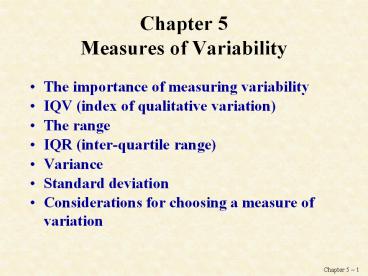Chapter 5 Measures of Variability PowerPoint PPT Presentation
1 / 12
Title: Chapter 5 Measures of Variability
1
Chapter 5Measures of Variability
- The importance of measuring variability
- IQV (index of qualitative variation)
- The range
- IQR (inter-quartile range)
- Variance
- Standard deviation
- Considerations for choosing a measure of
variation
2
The Importance of Measuring Variability
- Central tendency
- Measures of variability
- - Numbers that
describe what is typical or average (central) in
a distribution. - -
Numbers that describe diversity or variability in
the distribution.
These two types of measures together help us to
sum up a distribution of scores without looking
at each and every score. Measures of central
tendency tell you about typical (or central)
scores. Measures of variation reveal how far from
the typical or central that the distribution
tends to vary.
3
Index of Qualitative Variation
- IQV A measure of variability for nominal
variables. It is based on the ratio of the total
number of differenced in the distribution to the
maximum number of possible differences within the
same distribution.
where K number of categories in the
variable N total number of cases
4
Understanding the Index of Qualitative Variation
- The IQV is a single number that expresses the
diversity of a distribution. - The IQV ranges from 0 to 1
- An IQV of 0 would indicate that the distribution
has NO diversity at all. - An IQV of 1 would indicate that the distribution
is maximally diverse.
5
IQV in Real Life Diversity in the U.S.
Racial and Ethnic Diversity as Measured by the
IQV for the Fifty States, 1998
6
The Range
- Range highest score - lowest score
- Range A measure of variation in interval-ratio
variables. It is the difference between the
highest (maximum) and the lowest (minimum) scores
in the distribution.
7
Inter-quartile Range
- Inter-quartile range (IQR) The width of the
middle 50 percent of the distribution. It is
defined as the difference between the lower and
upper quartiles (Q1 and Q3.) - Iqr q3 q1
8
The Box Plot
- The Box Plot is a graphic device that visually
presents the following elements the range, the
inter-quartile range, the median, the quartiles,
the minimum (lowest value,) and the maximum
(highest value.)
9
Variance
- Variance A measure of variation for
interval-ratio variables it is the average of
the squared deviations from the mean
10
Standard Deviation
- Standard Deviation A measure of variation for
interval-ratio variables it is equal to the
square root of the variance.
11
Find the Mean and the Standard Deviation
12
Considerations for Choosing a Measure of
Variability
- For nominal variables, you can only use IQV
(index of qualitative variation). - For ordinal variables, you can calculate the IQV
or the IQR (inter-quartile range.) Though, the
IQR provides more information about the variable. - For interval-ratio variables, you can use IQV,
IQR, or variance/standard deviation. The
standard deviation (also variance) provides the
most information, since it uses all of the values
in the distribution in its calculation.

